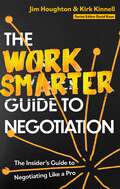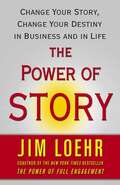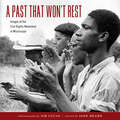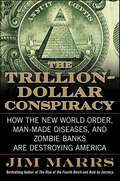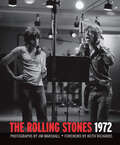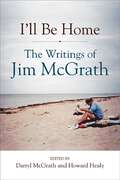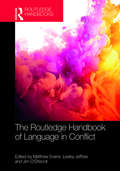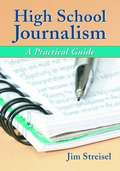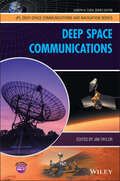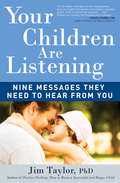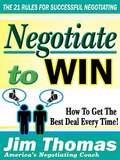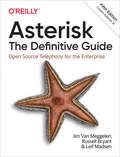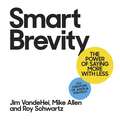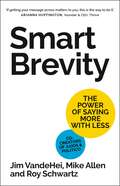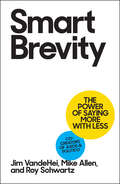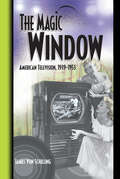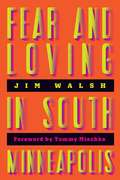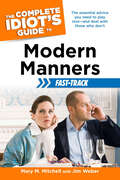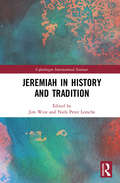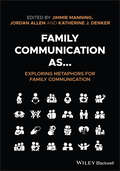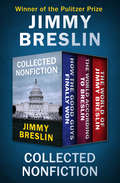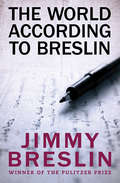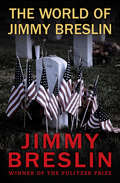- Table View
- List View
The Work Smarter Guide to Negotiation: The Insider's Guide to Negotiating Like a Pro (Work Smarter Series)
by Jim Houghton Kirk KinnellDitch the scripts and tricks for a smarter approachKirk Kinnell is a hostage negotiator and counter-terrorism expert with decades of experience. Jim Houghton has conducted complex M&A deals worth hundreds of millions. Despite their dramatically different backgrounds, they share the philosophy that negotiation is not a zero-sum game and that trust, integrity and fairness are essential to achieving a successful outcome.This book combines their vast knowledge to show you how to prepare for and conduct negotiations in almost any environment. What holds true for ending a siege or keeping a hostage alive could be the key to getting your toddler off to bed or agreeing a pay rise with your boss. Their invaluable advice will help you be resourceful and calm amid the stress and volatility of real-world negotiations.In business, this equates to winning repeat business and making more profit. In our personal lives, it means family harmony and better communities. If you are booking a wedding caterer or finding a builder for that long hoped-for renovation, it means seeing eye to eye and helping everyone get what they need on terms acceptable to them. And in hostage situations, it means saving lives. These techniques work at the highest level, and they will work for any situation you might face.The Work Smarter series:The 'Work Smarter' series of books provide shortcuts, tips and life-hacks for the development of essential business skills. The books bring together accomplished industry experts who have learned their trades at the coalface. They teach the skills ambitious businesspeople need in order to tip the playing field in their favour. It is the pirate equivalent of business advice; the antidote to conventional wisdom; 'smarter' practice over 'best practice'.
The Work Smarter Guide to Negotiation: The Insider's Guide to Negotiating Like a Pro (Work Smarter Series)
by Jim Houghton Kirk KinnellDitch the scripts and tricks for a smarter approachKirk Kinnell is a hostage negotiator and counter-terrorism expert with decades of experience. Jim Houghton has conducted complex M&A deals worth hundreds of millions. Despite their dramatically different backgrounds, they share the philosophy that negotiation is not a zero-sum game and that trust, integrity and fairness are essential to achieving a successful outcome.This book combines their vast knowledge to show you how to prepare for and conduct negotiations in almost any environment. What holds true for ending a siege or keeping a hostage alive could be the key to getting your toddler off to bed or agreeing a pay rise with your boss. Their invaluable advice will help you be resourceful and calm amid the stress and volatility of real-world negotiations.In business, this equates to winning repeat business and making more profit. In our personal lives, it means family harmony and better communities. If you are booking a wedding caterer or finding a builder for that long hoped-for renovation, it means seeing eye to eye and helping everyone get what they need on terms acceptable to them. And in hostage situations, it means saving lives. These techniques work at the highest level, and they will work for any situation you might face.The Work Smarter series:The 'Work Smarter' series of books provide shortcuts, tips and life-hacks for the development of essential business skills. The books bring together accomplished industry experts who have learned their trades at the coalface. They teach the skills ambitious businesspeople need in order to tip the playing field in their favour. It is the pirate equivalent of business advice; the antidote to conventional wisdom; 'smarter' practice over 'best practice'.
Collaborative Intelligence: The New Way to Bring Out the Genius, Fun, and Productivity in Any Team
by Mariano Battan Jim KalbachCreate better connected teams and hold more productive meetings In Collaborative Intelligence: Design Better Collaboration, Improve Team Productivity, and Build a Culture of Connection, the workplace collaboration experts at MURAL offer a holistic and comprehensive system for fixing today’s broken teamwork culture. This book introduces the emerging practice of collaboration design, a cutting-edge approach to crafting collaborative experiences with a high degree of intentionality so that they deliver extraordinary, repeatable outcomes. With a strong focus on activities and rituals that can be used by leaders and team members right now, the authors show businesses how they can innovate faster than ever. Readers will learn the skills they need to enable better collaboration, whether their teams are hybrid, remote, in-person, synchronous, or asynchronous. Based on decades of research, experience, and observations from working with thousands of teams globally in all kinds of collaboration spaces, this highly visual book provides the instruction you need to fix teamwork, transform your organization, and re-imagine what’s possible at work. You’ll also find: How to build playbooks of collaboration methods How to create an inclusive, equitable, and collaborative environment that invites participation and unlocks the genius of your teams How to access unprecedented insights into how collaboration happens in your organization Strategies for leading collaboration change at the organization levelA can’t-miss guide for knowledge-work professionals, Collaborative Intelligence provides the direction you’ve been looking for to help teams innovate together.
The Power of Story: Rewrite Your Destiny in Business and in Life
by Jim LoehrNew York Times bestselling coauthor of The Power of Full Engagement, examines the way we tell stories about ourselves to ourselves and, most importantly, the way we can change those stories to transform our business and personal lives. "Your story is your life," says Loehr. As human beings, we continually tell ourselves stories—of success or failure; of power or victimhood; stories that endure for an hour, or a day, or an entire lifetime. We have stories about our work, our families and relationships, our health; about what we want and what we're capable of achieving. Yet, while our stories profoundly affect how others see us and we see ourselves, too few of us even recognize that we're telling stories, or what they are, or that we can change them—and, in turn, transform our very destinies. Telling ourselves stories provides structure and direction as we navigate life's challenges and opportunities, and helps us interpret our goals and skills. Stories make sense of chaos; they organize our many divergent experiences into a coherent thread; they shape our entire reality. And far too many of our stories, says Loehr, are dysfunctional, in need of serious editing. First, he asks you to answer the question, "In which areas of my life is it clear that I cannot achieve my goals with the story I've got?" He then shows you how to create new, reality-based stories that inspire you to action, and take you where you want to go both in your work and personal life. For decades, at the Human Performance Institute, Loehr has been examining the power of story to increase engagement and productivity, and Fortune 500 companies have paid millions to send employees to his program, in which he applies the principles and methods that he now offers in this book. Global business leaders, world-class athletes, military special forces, and thousands of individuals from every walk of life have sought out and benefited from his life-altering insight and expertise. Our capacity to tell stories is one of our profoundest gifts. Loehr's approach to creating deeply engaging stories will give you the tools to wield the power of storytelling and forever change your business and personal life.
A Past That Won't Rest: Images of the Civil Rights Movement in Mississippi
by Jim LucasContributions by Howard Ball, Peter Edelman, Aram Goudsouzian, Robert E. Luckett Jr., Ellen B. Meacham, Stanley Nelson, and Charles L. OverbyA Past That Won't Rest: Images of the Civil Rights Movement in Mississippi collects never-before-published photographs taken by Jim Lucas (1944-1980), an exceptional documentary photographer. His black-and-white images, taken during 1964 through 1968, depict events from the civil rights movement including the search for the missing civil rights workers in Neshoba County, the Meredith March Against Fear, Senator Robert F. Kennedy's visit to the Mississippi Delta, and more. The photographs exemplify Lucas's technical skill and reveal the essential truth in his subjects and the circumstances surrounding them.Lucas had a gift for telling a visual story, an instinctive eye for framing his shots, and a keen human sensibility as a photojournalist. A college student in Jackson, Mississippi, in 1964, he was on his way to becoming a professional photojournalist when Freedom Summer exploded. Lucas found himself in the middle of events that would command the attention of the whole world. He cultivated his contacts and honed his craft behind the camera as a stringer for Time and Life magazines as well as the Associated Press. Lucas tragically lost his life in a car accident in 1980, but his photographs have survived and preserve a powerful visual legacy for Mississippi. Over one hundred gorgeously sharp photographs are paired with definitive essays by scholars of the events depicted, thereby adding insight and historical context to the book. Charles L. Overby, a fellow Jacksonian and young journalist at the time, provides a foreword about growing up in that tumultuous era.
The Trillion-Dollar Conspiracy: How the New World Order, Man-Made Diseases, and Zombie Banks Are Destroying America
by Jim Marrs“Jim Marrs can’t be ignored. Few in this country shout about The Truth louder than he.”—Dallas ObserverIn The Trillion-Dollar Conspiracy, Jim Marrs, the New York Times bestselling author of Rule by Secrecy and The Rise of The Fourth Reich, offers a terrifying proposition: that the current economic collapse has been engineered by a tyrannous government and multinational corporations determined to enslave us. Read The Trillion-Dollar Conspiracy and find out how the New World Order, man-made diseases, and zombie banks are destroying America.
The Rolling Stones 1972
by Jim MarshallA pictorial chronicle of the Stones’ classic summer concert tour from the Life magazine photographer who followed them—with a foreword by Keith Richards.In 1972, the Rolling Stones marked their first decade as a band with the release of Exile on Main St. and a summer concert tour of America that set new standards for magnificence in live performance. Covering the tour for Life magazine, photographer Jim Marshall captured indelible moments of the Stones in their glory onstage, as well as the camaraderie behind the scenes. Featuring a foreword by Keith Richards, this volume presents Marshall’s shots alongside dozens of never-before-seen frames. Stones fans will revel in this unprecedented look at one of the biggest rock bands of all time from the photographer who captured them best.“The stunning images in this collection show the Stones in all their strung-out Exile on Main Street-era splendor—recording in Los Angeles, chilling backstage and strutting across some very lucky concert stages.” —Rolling Stone
I'll Be Home: The Writings of Jim McGrath (Excelsior Editions)
by Jim McGrathThe winner of more awards than any editorial writer in the Albany Times Union's history, Jim McGrath was both an Albany institution and a keen observer of the world beyond his beloved adopted city. When he died in 2013 at the age of fifty-six, the newspaper lost a writer who combined a passionate advocacy for society's most vulnerable people with a scathing disregard for the elite whose actions created an underclass in the United States. His writing was often elegiac, but his take on his adopted home state of New York and his beloved Albany was variously bemused, witty, irreverent, and indignant. He could relate to the plight of the minimum-wage worker as easily as he could talk to a US senator, and he feared no one. His editorials and commentaries charted many of the most critical issues in New York and the country: the death penalty, civil liberties, gay rights, historic presidential campaigns, the economy, terrorism, and more—all with an incisiveness that remains relevant, if not more so, in the present political era.In addition to his editorials and op-eds, I'll Be Home contains essays, critiques, and other writings that have never before been published, as well as appraisals of his work and life by former colleagues Rex Smith, Fred LeBrun, Dan Lynch, and others. The book is both a tribute to a memorable newspaperman and an insider's perspective on politics and life through the lens of an editorial writer, a position that Jim described as "a great seat at a really weird show."
The Routledge Handbook of Language in Conflict (Routledge Handbooks in Applied Linguistics)
by Lesley Jeffries Matthew Evans Jim O'DriscollThe Routledge Handbook of Language in Conflict presents a range of linguistic approaches as a means for examining the nature of communication related to conflict. Divided into four sections, the Handbook critically examines text, interaction, languages and applications of linguistics in situations of conflict. Spanning 30 chapters by a variety of international scholars, this Handbook: includes real-life case studies of conflict and covers conflicts from a wide range of geographical locations at every scale of involvement (from the personal to the international), of every timespan (from the fleeting to the decades-long) and of varying levels of intensity (from the barely articulated to the overtly hostile) sets out the textual and interactional ways in which conflict is engendered and in which people and groups of people can be set against each other considers what linguistic research has brought, and can bring, to the universal aim of minimising the negative effects of outbreaks of conflict wherever and whenever they occur. The Routledge Handbook of Language in Conflict is an essential reference book for students and researchers of language and communication, linguistics, peace studies, international relations and conflict studies.
High School Journalism: A Practical Guide
by Jim StreiselHigh school journalists share the same objectives as professional reporters--finding the story, writing the story, and packaging the story so that it appeals to an audience. Understanding how to best accomplish these objectives is key to the student on the newspaper, yearbook or Web site staff, but the fundamental art of storytelling and story presentation are not always at the center of high school journalism classes. Student journalists must first understand that storytelling, at its most basic level, is about people, and that understanding the audience is essential in deciding how to present the story. This handbook for high school journalists and teachers offers practical tips for all elements of school journalism. The author covers the essential components that students must understand: information gathering, writing, standard and alternative coverage and packaging. Students will find valuable information about identifying news, interviewing, research, narrative writing style, editing, visual presentation and layout. The book also covers the legal rights of student journalists, objective vs. opinion writing, staff planning and organization and Web-based journalism. Each chapter includes study guides for practical applications of the concepts discussed. Instructors considering this book for use in a course may request an examination copy here.
Deep Space Communications
by Jim TaylorA collection of some of the Jet Propulsion Laboratory's space missions selected to represent the planetary communications designs for a progression of various types of missions The text uses a case study approach to show the communications link performance resulting from the planetary communications design developed by the Jet Propulsion Laboratory (JPL). This is accomplished through the description of the design and performance of six representative planetary missions. These six cases illustrate progression through time of the communications system's capabilities and performance from 1970s technology to the most recent missions. The six missions discussed in this book span the Voyager for fly-bys in the 1970s, Galileo for orbiters in the 1980s, Deep Space 1 for the 1990s, Mars Reconnaissance Orbiter (MRO) for planetary orbiters, Mars Exploration Rover (MER) for planetary rovers in the 2000s, and the MSL rover in the 2010s. Deep Space Communications: Provides an overview of the Deep Space Network and its capabilities Examines case studies to illustrate the progression of system design and performance from mission to mission and provides a broad overview of the missions systems described Discusses actual flight mission telecom performance of each system Deep Space Communications serves as a reference for scientists and engineers interested in communications systems for deep-space telecommunications link analysis and design control. Jim Taylor is a principal engineer at JPL, working on telecommunications analysis, ground-system implementation, and flight operations for deep-space and Earth-orbiting projects. He was the founding telecommunications member of JPL's Spaceflight Significant Events Group, now called Lessons Learned. He received the NASA Exceptional Achievement Medal in 2000 for innovative use of the DS1 communications systems and the NASA Exceptional Service Medal in 2006 for operational development and support on Deep Impact.
Your Children Are Listening: Nine Messages They Need to Hear from You
by Jim TaylorChildren become the messages they get the most. And as a parent, your words, attitudes, and actions are constantly sending your children messages, creating their earliest ideas about themselves, others, and the world around them. Now, parenting expert Dr. Jim Taylor describes the vital opportunity you have to shape your children (even when they may not appear to be listening) and guides you to answer this crucial question: “How can I be sure I’m sending the healthiest messages?” If you consciously send your children the right messages, the benefits for them will be profound. Your Children Are Listening offers: Nine essential messages all children need to hear—on love, competence, security, compassion, gratitude, nature, respect, responsibility, and emotionWhy these messages are so importantThe different “conduits” through which children receive your messages“Message blockers” that can prevent them from getting throughAnd fun catchphrases and activities you can use to send these messages every day!
Negotiate to Win: The 21 Rules for Successful Negotiating
by Jim ThomasNegotiation is one skill everyone needs in order to get more of what they want-to sell more, to earn more, to keep costs down, to manage better, and to strengthen relationships. In Negotiate to Win, master negotiator Jim Thomas shows you exactly how the best negotiators reach long-lasting, positive solutions-ones that build profits, performance, and relationships-with his 21 rules for successful negotiating. Learn how to overcome your natural reluctance to bargain, how to negotiate ethically (and deal with those who don't), and how to negotiate successfully across cultural lines. Negotiate with your boss, your children, your auto mechanic, and more. Once you learn how to negotiate to win, you'll always get the best deal.
Asterisk: Open Source Telephony for the Enterprise
by Leif Madsen Jim Van Meggelen Russell BryantDesign a complete Voice over IP (VoIP) or traditional PBX system with Asterisk, even if you have only basic telecommunications knowledge. This bestselling guide makes it easy with a detailed roadmap that shows you how to install and configure this open source software, whether you’re upgrading your existing phone system or starting from scratch.Ideal for Linux administrators, developers, and power users, this updated fifth edition shows you how to set up VoIP-based private telephone switching systems within the enterprise. You’ll get up to speed on the features in Asterisk 16, the latest long-term support release from Digium. This book also includes new chapters on WebRTC and the Asterisk Real-time Interface (ARI).Discover how WebRTC provides a new direction for AsteriskGain the knowledge to build a simple but complete phone systemBuild an interactive dialplan, using best practices for Asterisk’s advanced featuresLearn how ARI has emerged as the API of choice for interfacing web development languages with Asterisk
Smart Brevity: The Power of Saying More with Less
by Mike Allen Jim VandeHei Roy SchwartzThe guide to saying more with less.Brevity is confidence. Length is fear. This is the guiding principle of Smart Brevity, a communication formula built by Axios journalists to prioritize essential news and information, explain its impact and deliver it in a concise and visual format. Now, the co-founders of Axios have created an essential guide for communicating effectively and efficiently using Smart Brevity - think Strunk and White's Elements of Style for the digital age.In SMART BREVITY: The Power of Saying More with Less, Axios co-founders Jim VandeHei, Mike Allen, and Roy Schwartz teach listeners how to say more with less in virtually any format. They also share communications lessons learned from their decades of experience in media, business and communications.(P) 2023 Algonquin Books
Smart Brevity: The Power of Saying More with Less
by Mike Allen Jim VandeHei Roy SchwartzA WALL STREET JOURNAL AND USA TODAY NATIONAL BESTSELLER!Brevity is confidence. Length is fear. This is the guiding principle of Smart Brevity, a communication formula built by Axios journalists to prioritize essential news and information, explain its impact and deliver it in a concise and visual format. Now, the co-founders of Axios have created an essential guide for communicating effectively and efficiently using Smart Brevity - think Strunk and White's Elements of Style for the digital age.In SMART BREVITY: The Power of Saying More with Less, Axios co-founders Jim VandeHei, Mike Allen, and Roy Schwartz teach readers how to say more with less in virtually any format. They also share communications lessons learned from their decades of experience in media, business and communications.
Smart Brevity: The Power of Saying More with Less
by Mike Allen Jim VandeHei Roy SchwartzBrevity is confidence. Length is fear. This is the guiding principle of Smart Brevity, a communication formula built by Axios journalists to prioritize essential news and information, explain its impact and deliver it in a concise and visual format. Now, the co-founders of Axios have created an essential guide for communicating effectively and efficiently using Smart Brevity—think Strunk and White&’s Elements of Style for the digital age. In SMART BREVITY: The Power of Saying More with Less, Axios co-founders Jim VandeHei, Mike Allen, and Roy Schwartz teach readers how to say more with less in virtually any format. They also share communications lessons learned from their decades of experience in media, business and communications.
The Magic Window: American Television ,1939-1953
by Jim Von SchillingFirst published in 2002. Routledge is an imprint of Taylor & Francis, an informa company.
Fear and Loving in South Minneapolis
by Jim WalshA veteran Twin Cities journalist and raconteur summons the life of the city after reporting and recording its stories for more than thirty years Two or three times a week, as a columnist, hustling freelance writer, and genuinely curious reporter, Jim Walsh would hang out in a coffee shop or a bar, or wander in a club or on a side street, and invariably a story would unfold—one more chapter in the story of Minneapolis, the city that was his home and his beat for more than thirty years. Fear and Loving in South Minneapolis tells that story, collecting the encounters and adventures and lives that make a city hum—and make South Minneapolis what it is. Here is a man who drives around Minneapolis in a van that sports a neon sign and keeps a running tally of the soldiers killed in Iraq. Here is another, haunted by the woman he fell in love with, and lost, many years ago at the Minnesota Music Café on St. Paul&’s East Side. Here are strangers on a cold night on the corner of Forty-sixth and Nicollet, finding comfort in each other&’s company in the wake of the shootings in Paris. And here are Walsh&’s own memories catching up with him: the woman who joined him in representing &“junior royalty&” for the Minneapolis Aquatennial when they were both seven years old; the lost friend, Soul Asylum&’s Karl Mueller, recalled while sitting on his memorial bench at Walsh&’s go-to refuge, the Rose Gardens near Lake Harriet. These everyday interactions, ordinary people, and quiet moments in Jim Walsh&’s writing create an extraordinary picture of a city&’s life. James Joyce famously bragged that if Dublin were ever destroyed, it could be rebuilt in its entirety from his written works. The Minneapolis that Jim Walsh maps is more a matter of heart, of urban life built on human connections, than of streets intersecting and literal landmarks: it is that lived city, documented in measures large and small, that his book brings so vividly to mind, drafting a blueprint of a community&’s soul and inviting a reader into the boundless, enduring experience of Fear and Loving in South Minneapolis.
The Complete Idiot's Guide to Modern Manners Fast-Track: The Essential Advice You Need to Play Nice—and Deal with Those Who Don’t
by Mary Mitchell Jim WeberTechnology is changing society faster than anyone could have imagined even a few short years ago. People share intimate details to hundreds of acquaintances online, yet they are stumped when it comes to writing a simple thank-you note. They talk, text, and surf on their phones constantly but seem oblivious to the needs of the people who are right in front of them. The Complete Idiot's Guide® to Modern Manners, Fast Track, helps people navigate the uncertain waters of modern social behavior and gives them tips for overcoming the most common miserable moments they're likely to encounter. In it, readers learn how to: Make a good first impression in person, over the phone, in print, and online. Practice good table manners in a world of buffets, informal meals, and a proliferation of restricted diets. Get along with neighbors and their pets, kids, habits, and hobbies. Maintain harmony in the office despite the more casual nature of the workplace. Master the social possibilities of online networking, texting, and smartphones while avoiding embarrassing faux pas. Whip out the old-fashioned pen for written correspondence that makes an impact. Communicate comfortably in person, including small talk, defusing tense situations, and avoiding subjects that are still too uncomfortable for polite conversation. Navigate the difficult situations that arise when traveling and out on the town. Maintain genuine respect for others' differences and disabilities. Be the model of manners at celebrations of life's milestone moments, including weddings and births. Get the right answer to all gift quandaries People are busy and no longer have the time or inclination to comb through Emily Post. This quick book helps readers get the answers they need so they can get on with life.
Jeremiah in History and Tradition (Copenhagen International Seminar)
by Jim West Niels Peter LemcheJeremiah in History and Tradition examines aspects of the Book of Jeremiah from a variety of perspectives including historical, textual, redaction, and feminist criticism, as well as the history of its reception. The book looks afresh at the Book of Jeremiah through the lens of intertextuality and reception history in the broadest sense, exploring Jeremiah in its historical context as well as the later history and interpretation of the text, and also reconsidering aspects of the Book of Jeremiah’s traditions. This volume features essays from a unique assembly of scholars, both seasoned and new. It is divided into two parts: "Jeremiah in History", which explores a variety of readings of Jeremiah from the point of view of classical historical criticism; and "Jeremiah in Tradition", which discusses the portraits and use of both the book and the figure of Jeremiah in extra-biblical traditions. Offering challenging new theories, Jeremiah in History and Tradition is invaluable to scholars and students in the field of Biblical Studies. It is a useful resource for anyone working on the interpretation of the biblical text and the readings of the text of Jeremiah throughout history.
Family Communication as... Exploring Metaphors for Family Communication
by Jimmie Manning Jordan Allen Katherine J. DenkerAn innovative textbook that presents a novel and compelling examination of family communication studies Family Communication as… Exploring Metaphors for Family Communication presents a series of metaphors through which students explore the nuances and complexities of family interaction. With a unique approach to the foundational theories and real-world practices of family communication, this easily accessible textbook helps students develop a clear understanding of what family communication is and what it can be. Contributions by both prominent and newer scholars theorize about family communication, offer new perspectives, challenge long-held assumptions, and describe original research to provide students with an up-to-date representation of the leading thinking in the field. Each concise chapter focuses on a specific element of family life, engaging key metaphors to stimulate classroom discussion about family in contexts ranging from ritual and embodiment to estrangement and heteronormativity. Throughout the text, students examine family metaphorically—as memory, as social identity, as estrangement, as loss, as resilience, as raced, and more. Presents a metaphorical examination of creating, materializing, contextualizing, politicizing, and complicating family communication Offers an innovative alternative to standard textbooks on the subject Features a thorough introduction advocating for the use of metaphors in teaching Discusses the key topics and theoretical approaches that have defined the field Includes detailed references, additional readings, and an instructor&’s companion website Family Communication as… Exploring Metaphors for Family Communication is an excellent textbook for advanced undergraduate and graduate students in courses including family communication, family studies, interpersonal communication, relational communication, and communication theory. It is also a highly useful resource for scholars in fields such as media studies, psychology, sociology, social work, counseling, and public health.
Collected Nonfiction: How the Good Guys Finally Won, The World According to Breslin, and The World of Jimmy Breslin
by Jimmy BreslinColorful, riveting reportage from a one-of-a-kind Pulitzer Prize–winning journalist and New York Times–bestselling author. In his career as a legendary New York City newspaper columnist, Jimmy Breslin “leveled the powerful and elevated the powerless for more than fifty years with brick-hard words and a jagged-glass wit” (The New York Times). How the Good Guys Finally Won: Following the burglary of the Democratic National Committee headquarters at the Watergate Hotel, as evidence increasingly mounted against President Richard Nixon, Thomas “Tip” O’Neill, the Majority Leader in the House of Representatives, led the charge calling for impeachment. In this New York Times bestseller, Breslin’s blow-by-blow, conviction-by-conviction account is a gripping reminder of how O’Neill and his colleagues brought justice to those who abused their power, and revived America after the greatest political scandal in its history. “Breslin’s reporting is superb and so is his prose, his insights keen and often startling, his wit unceasing.” —Chicago Tribune The World According to Breslin: In an illustrious career that spanned decades, the seven years that Breslin spent at the New YorkDaily News sparked some of his finest work. When New York City tumbled into economic and social chaos at the end of the 1970s, Breslin was there. In this collection of classic columns, he looks at the city not from the top down but from the bottom up, heralding the heroism of average New Yorkers. “Superb . . . a master of the tough-talking, thoroughly researched, contentious, street-wise vignette.” —San Francisco Chronicle The World of Jimmy Breslin: In the 1960s, as the once-proud New York Herald Tribune spiraled into bankruptcy, the brightest light in its pages was an ebullient young columnist named Jimmy Breslin. While ordinary columnists wrote about politics, culture, or the economy, Breslin’s chief topics were the city and himself. He was chummy with cops, arsonists, and thieves, and told their stories with grace, wit, and lightning-quick prose. Whether covering the five boroughs, Vietnam, or the death of John F. Kennedy, Breslin managed to find great characters wherever he went. “Breslin’s touch is absolutely sure.” —The Washington Post Book World
The World According to Breslin: How The Good Guys Finally Won, The World According To Breslin, And The World Of Jimmy Breslin
by Jimmy BreslinClassic columns from the legendary New York journalist—&“a master of the tough-talking, thoroughly researched, contentious, street-wise vignette&” (San Francisco Chronicle). Although his career spans decades, the seven years that Jimmy Breslin spent at the New YorkDaily News sparked some of his finest work. When New York City tumbled into economic and social chaos at the end of the 1970s, Breslin was there. In his brief, insightful columns, he looked at the city not from the top down but from the bottom up. Eschewing the view of politicians, socialites, and captains of industry, Breslin&’s heroes are men like Jim Moran, the cop who drove John Lennon to the emergency room after he was shot, or Barney Baker, an ex-boxer who served as bodyguard to mobster Meyer Lansky. These are average people who see big things, and Breslin is their herald. This ebook features an illustrated biography of Jimmy Breslin including rare photos and never-before-seen documents from the author&’s personal collection.
The World of Jimmy Breslin: World Without End, Amen; The Gang That Couldn't Shoot Straight; Table Money; And Forsaking All Others
by Jimmy BreslinThe Pulitzer Prize–winning journalist&’s early columns &“peopled by some of the funniest, looniest and saddest characters anywhere outside of a zoo&” (The New York Times). In the 1960s, as the once-proud New York Herald Tribune spiraled into bankruptcy, the brightest light in its pages was an ebullient young columnist named Jimmy Breslin. While ordinary columnists wrote about politics, culture, or the economy, Breslin&’s chief topics were the city and Breslin himself. He was chummy with cops, arsonists, and thieves, and told their stories with grace, wit, and lightning-quick prose. Whether covering the five boroughs, Vietnam, or the death of John F. Kennedy, Breslin managed to find great characters wherever he went. This collection includes some of Breslin&’s most famous early writing. Here are the unforgettable New Yorkers Sam Silverware and Larry Lightfingers, the celebrated interview with President Kennedy&’s gravedigger, and the classic &“People I&’m Not Talking To Next Year.&” But the most important voice here is Breslin&’s—as vibrant as ever. This ebook features an illustrated biography of Jimmy Breslin including rare photos and never-before-seen documents from the author&’s personal collection.
